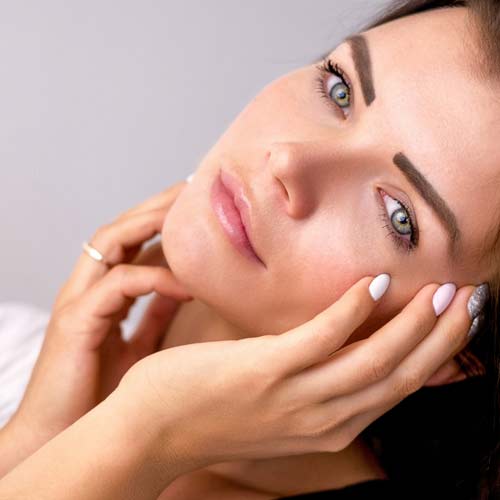Mature Skin: Learn to Identify Your Skin Type
As we age we need to alter our beauty routine in order to accommodate for the changes that occur over time in our skin.
My website aims at helping you look healthy and the best you can for your age. Beauty is not a competition, it doesn’t belong to the youth and it has nothing to do with being winkle-free.
Beauty is a way of Being.
Mature skin tends to be on the ‘dryer’ side but it is possible that your skin is oily or combination (as well as sensitive).
We’ve already looked at what happens to your skin as you age so now it’s time for you to be able to identify what’s your skin type.
7 Quick Ways to Identify Your Aging Skin Type (The Easy Guide)
Aging skin? Yep, it happens to all of us. But here’s the thing—your skin isn’t just “aging.” It has a type, and knowing what type you’re dealing with makes all the difference when it comes to skincare.
Because let’s be real—there’s nothing worse than slathering on products that don’t actually do anything for your skin. Dry? Oily? Sensitive? Combo? It’s time to figure it out.
Let’s break it down into seven super simple ways to identify your aging skin type (without overcomplicating it).
1. Your skin after cleansing tells you a lot
Wash your face with a gentle cleanser, pat it dry, and wait 30 minutes. No moisturizers, no toners—just let your skin chill. Now check:
- Feels tight? Dry skin.
- Looks shiny? Oily skin.
- A bit of both? Combination skin.
- Feels normal? Lucky you—balanced skin!
- Stings, burns, or gets red? Sensitive skin.
2. Your fine lines and wrinkles have patterns
- Dry skin: Lines show up earlier and can look deeper because of lack of moisture.
- Oily skin: You might notice fewer fine lines, but sagging or large pores may be more of a concern.
- Combo skin: Some areas (like your forehead) may wrinkle faster than others.
- Sensitive skin: Wrinkles might be accompanied by redness or irritation.
3. Your skin’s texture gives away your type
Run your fingers across your face—what do you feel?
- Rough or flaky? Dry skin.
- Slick or greasy? Oily skin.
- Some areas rough, some smooth? Combination skin.
- Gets irritated easily? Sensitive skin.
4. How your skin reacts to the weather
- If winter makes you feel like a dried-out raisin → Dry skin.
- If summer turns you into an oil slick → Oily skin.
- If you get both issues depending on the season → Combination skin.
- If wind, heat, or cold makes you red and irritated → Sensitive skin.
5. Makeup never lies
- Dry skin: Foundation clings to dry patches or looks cakey.
- Oily skin: Makeup slides off by midday (hello, shine!).
- Combo skin: T-zone gets oily, but your cheeks stay dry.
- Sensitive skin: Certain makeup causes irritation or redness.
6. Pores—big, small, or in-between?
Check the pores on your nose, forehead, and cheeks:
- Small, barely visible? Dry skin.
- Larger, noticeable? Oily skin.
- A mix—larger on the nose, smaller on the cheeks? Combination skin.
- Inflamed or easily irritated? Sensitive skin.
7. How your skin feels at the end of the day
- Dry skin: Feels tight or itchy, even if you wore moisturizer.
- Oily skin: Feels greasy, especially on the forehead and nose.
- Combo skin: T-zone gets shiny, but cheeks still feel normal or dry.
- Sensitive skin: Might be a little red or reactive, depending on the products you used.
So, what’s your skin type?
Now that you’ve got the signs, you can match them up and finally know what you’re working with. Understanding your aging skin type means you can choose the right skincare (instead of guessing and hoping for the best).
When you actually know what your skin needs, your routine gets way easier.
Less guessing, better results.
Time to level up your skincare game!
Recap
Just as a quick recap, here’s what happens to your skin as you age:
- Thinning of the skin
- Appearance of dry patches
- Age spots
- Spider veins
- Sagging skin
- Fine lines and wrinkles
Whatever your skin type you will ALWAYS benefit from giving it attention and regular care. A daily regime is optimal although I must admit I don’t follow this ‘rule’ 100% all of the time. At times I have found it impossible to follow my beauty routine (when I’m staying at relatives or the time I was building my home) which made it very difficult for me to follow a regime.
Still, I didn’t feel I was failing; I knew these were times where it was just impossible for me to follow through. And that’s ok. As long as you go back to your routine you’ll be fine.
Identify Your Skin Type (A Quick Skin Type Guide)

Normal skin will feel smooth and supple and is not prone to acne. As we get older it tends to go on the dryer side thus requiring richer moisturisers.
Combination skin will be oily in some places and normal or dry in others. It will probably have visible pores, shiny skin on the forehead and the breakouts as well as patches of flaky skin.
Oily skin shows shiny patches and is usually prone to acne and pimples. Pores can show up as enlarged particularly around the nose and chin which contribute to the excess of sebum (oil) production.
Dry skin shows visible lines, redness, flakiness, less elasticity, dry patches and invisible pores (which might be something some people like). Less elasticity means puffier eyes.
Sensitive skin is prone to redness and itching as well as flaking of the skin. It can be susceptible to allergic reactions. Acne, psoriasis, rosacea and eczema can show up. Better to always patch test products you’ve never tried before to be on the safe side.
Don’t Worry if You’re Not Sure of Your Skin Type
Maybe your skin hasn’t changed that much over time or maybe you’re starting to see oiliness ‘disappear’ (that’s my particular case). Maybe you used to have dry skin and not you’re now seeing your skin getting even drier as time goes by.
Either way, don’t worry about changing skincare routine too much (if you already follow a routine, that is). In fact, a similar skincare routine should apply for young skin and mature skin but with mature skin we will make a few ‘adjustments’ or ‘refinements’ to your skincare in order to pay a close look at delicate skin, fine lines, wrinkles and hyperpigmentation.
Having mature skin means choosing natural products that contain ingredients which have high content of vitamin A, antioxidants, vitamin E, collagen-boosting, peptides and the right omega fatty acids.
Understanding Your Skin is the First Step!
Understanding your aging skin type is the first step to building a skincare routine that truly works for you. Whether your skin is dry, oily, combination, or sensitive, knowing what it needs allows you to choose products that nourish and support it rather than working against it.
Mature skin deserves extra care, but that doesn’t mean complicated routines. Small adjustments—like using richer moisturizers, protecting your skin from sun damage, and incorporating ingredients that support elasticity—can make all the difference.
Most importantly, skincare should be enjoyable, not a chore. Life happens, and sometimes routines get interrupted—that’s okay. What matters is that you find what works for you and return to your routine when you can.
Healthy, well-cared-for skin at any age is beautiful. 💛
